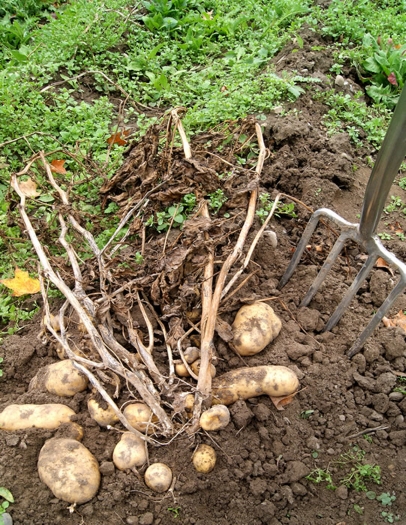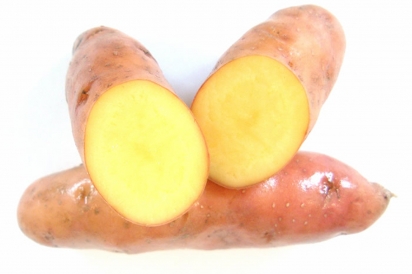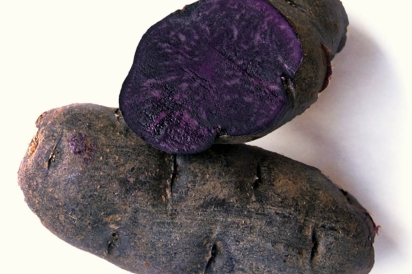All Things Potatoes
High in the Andes mountains there is a huge 150-metre deep terraced pit that is 15 degrees Celsius warmer at the bottom than at the top. This uncovered “greenhouse” served as an Incan agricultural research station. Here at Moray they could simulate growing conditions throughout their mountainous empire. One of their more important developments was the breeding of over three thousand varieties of potatoes. They also learned how to freeze-dry potatoes for easy transport and storage. With so much genetic diversity, the rulers had the capacity to reliably feed their expanding population in this challenging part of the world. I first saw this stunning site and heard the amazing story on a 1972 tour to the area, a couple of hours north of Cusco, Peru.
While spending a few months living and working in a small Cusco family restaurant, I got to know and love the locals’ favourite potato varieties – Papa Negra (black potato) and Yema de huevo (egg yolk potato). The black potato is available in Canada as Purple Peruvian. The egg-yolk-yellow potato is one of the parents used to breed Yukon Gold, the world famous variety released in 1980 by the late Gary Johnston and the University of Guelph. Unfortunately, there are several more productive (i.e., cheaper) yellow-fleshed imposters, but they lack the luscious flavour of the original.
HISTORICAL DEVELOPMENT
Toxic wild potatoes were first domesticated in northern Chile about 5000 BCE. They remained indigenous to the South American Andean region until the Spanish conquistadores arrived in their search for gold. They were not particularly interested in the plethora of new crops but they were interested enough in the productivity of potatoes to take a few varieties back to Seville in 1560.
It took over fifty years for them to share these samples with botanists throughout Europe. Even with the alluring botanical moniker of Solanum tuberosum (soothing root vegetable), it took another two hundred years to convince Europeans to eat these productive and nutritious roots. But with potatoes conveniently propagated by identical clones (rather than with genetically variable seeds), limited diversity pointed to an inevitable calamity. In 1845, a new fungus that could quickly decimate potatoes as a late blight arrived in Ireland from Mexico. With few food alternatives, a famine that lasted until 1851 devastated Ireland and parts of Europe.
Few of the original Incan potato varieties remained. Fortunately, one called Garnet Chile was resistant to the new fungus and has become the great-grandparent of almost all of the potatoes we know and love today. As the crop with the highest per-acre calorie production, its popularity quickly spread beyond Europe to North America, India and, more recently, to Northern China. Due to weight and perishability, however, very few potatoes are traded through international markets.
Potatoes are bred in much the same way as their close cousins, tomatoes. Flowers from two potato plants can be pollinated to produce what looks like a tiny cherry tomato. Seeds from this fruit will produce a myriad of new potato varieties. Researchers can then grow these out to see if any of the progeny will be superior to existing varieties. Whenever this happens, producers can clone the results as a new potato variety.
Our tax dollars (mostly in the U.S. but significantly in Canada) have been invested in several very expensive genetically modified potato varieties meant to confer insect- or late-blight resistance. But the primary customers (McDonald's, Burger King, and Frito-Lay) have announced that due to strong consumer resistance, they would not sell these. Monsanto therefore discontinued these GMOs, so all potato varieties continue to be bred by tried-and-true traditional methods.
NUTRITION
Potatoes contain fair amounts of a wide assortment of vitamins and minerals, with high quantities of potassium and vitamins B6 and C. Of prime importance, they are excellent sources of many beneficial phytonutrients and both crude and soluble fiber. All these nutrients are most available in and near the skin, so think about this before peeling your potatoes. Nutrient levels vary considerably depending on the variety, storage, and cooking method.
PURCHASING
Select potatoes with firm, smooth skins and no indication of decay, sprouts, or greening from exposure to light. There are two categories of potatoes (with some varieties exhibiting a bit of both):
Waxy are low starch, high protein varieties that remain firm after cooking. They are preferred for salads, boiling, roasting, grilling, and stewing, for which maintaining shape is desired.
Mealy are high starch, low protein varieties that fall apart with cooking. They are preferable for mashing, baking, and frying, and for pancakes, and dumplings, for which a smooth texture is preferred.
“New potatoes” are immature tubers with thin skins and a firm, waxy texture (even if a mealy variety). They often have more complex flavours. Since they do not keep well, only purchase enough for a few weeks.
Store potatoes in a dark, ventilated, cool (10º C) space. Storing in a (4º C) refrigerator would convert the starch into sugar, which is fine if you don’t mind sweeter potatoes. But don’t store potatoes meant for frying in the refrigerator because the sugar will burn before the potato is cooked. If potatoes meant for frying are inadvertently chilled, however, leaving them at room temperature for a week reverses the change.
QUALITY GROWING
Growing potatoes is more complicated than most vegetables, but the rewards of garden-fresh potatoes are memorable. They require loose, well-drained, fertile soil, and prefer low pH and full sun. If you are not sure about your soil, working in a generous amount of peat moss or pine needles will do no harm. Note that beds freshly dug from lawns often suffer from wireworms and grubs that also love potatoes. I’ve heard about the ingenious use of boxes, bags, and tires as creative solutions to poor garden soil. But these can easily become too hot for effectual tuber formation.
Rotating growing beds for potatoes is an important practice. Since plants are normally grown as clones, they tend to accumulate viral, fungal, and bacterial diseases. Faster growth from added compost (never raw manure) optimizes fertility and soil biology to help overcome diseases.
Seed potatoes should come from a certified potato seed producer. This provides confirmation that your seed has minimal disease pressure. (“Certified organic” is a different confirmation.) Or you may choose to use some of your own healthiest potatoes as seeds, but do not use store-bought potatoes as seeds because they are often treated with sprout inhibitors that would retard their growth.
If you are looking for a fine heirloom, you should be able to find the classic Early Rose (waxy) and Russet Burbank (mealy). Both of these are direct descendants of the Garnet Chile. Some of my favourite full-sized potatoes are Bintje (discerning chefs’ current go-to variety for French fries), German Butterball, Chieftain, Superior, and Yukon Gold. Fingerling potatoes generally have the richest flavour and look great presented without adornment. My favourites are Linzer Delikatess, Rose Finn Apple, Ratte, and French Fingerling. For coloured flesh, Purple Peruvian and Amarosa are firm and absolutely delicious.
If your seed is an early variety and you want to harvest them as early as possible, planting day can be the week before your last frost date. Otherwise, you can minimize many insect and weed issues by waiting until mid-June for your planting day. Many of the most flavourful late varieties are triggered to form tubers by shorter day length, so there is no advantage to earlier planting.
A couple of weeks prior to planting day, the seed potatoes should be coming out of dormancy by developing tiny sprouts from their “eyes.” If these are over ½-inch long, keep the potatoes in the refrigerator. If nothing is happening, keep the potatoes in a well-lit, warm (20º C) room until sprouts start to form. On planting day, cut larger potatoes into 2-ounce pieces that each have at least two or three eyes on them. Smaller (egg-sized) potatoes should be left whole.
Dig a narrow trench about 3 inches deep. Lay the seeds, cut side down, along the trench. For small fingerling potatoes these can be 6 inches apart; for mid-size spuds, set them at 12 inches apart, and for large-sized varieties, 18 inches apart is best. Adjacent rows should be about 30 inches apart. Rake soil back into the trench. (With the less vigorous fingerling varieties, cover them with no more than 2 inches of soil.)
Hilling the growing potatoes is important. Tubers are initiated on underground portions of the stems. So when the plants are about 4 inches high, rake loosened soil up against the stems and over the lower leaves. To keep the soil loose, I like to do this a couple of days after each heavy rain or irrigation. This process not only helps the tuber formation, it conveniently does most of the weeding and reduces evaporation. Continue hilling every couple of weeks to cover as much of the growing stems as practical. Stop hilling when flowers start to appear, because tubers start growing in the hills at that time. Reward yourself by “stealing” a few early potatoes as they swell in the hills.
During the early growing days, be on the lookout for Colorado potato beetles. First look for the striped brown bugs laying bright orange egg clusters on the underside of potato leaves. Stomp on the bugs and squish all the eggs. A few days later, look for and discard any brown larvae that hatched from any unsquished eggs. If you do this yucky job really well, you can be quickly finished for the year.
You may see some aphids, flea beetles, and leaf hoppers. But I find that with healthy plants they cause no serious problems. Keep the weeds short so they do not interfere with air circulation, which keeps the plants dry, so they will be less affected by late blight (from the same airborne fungus that affected the Irish), which usually arrives in mid-August. Midday watering helps keep the leaves dry during the night. Water enough (about 1 inch per week) to allow the tubers to grow well and to prevent scab (a corky skin disease) that indicates insufficient water. On the other hand, too much water can lead to scurf (a black, tarry skin disease). Both of these diseases are only skin deep so can still be used, but require peeling prior to cooking.
After the tops have died down for a couple of weeks, dig up a few potatoes to see if the skins have toughened enough to survive the rigour of harvesting. Stick a digging fork under the plants and then lift and shake the soil to make it more fun to gather the hidden gems buried underneath. Let them sit in the sun for a couple of hours to sterilize their skins. Then move them into a dark, 15º C room to cure (heal any scratches) for two weeks.
Store potatoes at 4º C in a refrigerator or dark, dry room for up to eight months. (I have found that when stored at 0º C they keep well for over twelve months.) But remember to store potatoes you intend to deep-fry at 8º C.
USING POTATOES
Mealy potatoes are the type of choice for fluffy mashed potatoes. As a main course, use them in shepherd’s pie, bubble and squeak, colcannon, boxty, or a Dutch stamppot. Other uses for mealy potatoes are baked, twice-baked, and decorative hasselback potatoes. Also be sure to use them for French fries and potato chips and as a stuffing in Indian samosas and Jamaican rotis. They are an important ingredient in Swiss rösti, Jewish latkes, and home fries and hash browns. Incorporate them into Indian masala dosas, Spanish tortillas, or Italian gnocchi. And they can be blended into a French vichyssoise or American chowder.
Waxy potatoes are the type of choice for firm boiled, steamed, roasted, grilled, skewered, and barbequed potatoes. They are also preferred for potato salads, scalloped potatoes, and all sorts of stews.
Bombay Potatoes
By David Cohlmeyer
Makes 6 servings
This comforting potato dish is often served as a simple healthy snack or meal in India. For a more substantial meal, cook some eggs on top of the potatoes during their final reheating. These also make a delightful accompaniment to any meal.
- 2 pounds unpeeled, well-washed waxy potatoes, cut into 3/4-inch chunks
- 1 cup water
- 1 tsp sea salt
- 6 whole fresh plum tomatoes
- 3 tbsp coconut oil
- 1 tbsp whole cumin seeds
- 1 tbsp whole coriander seeds
- 1 tbsp whole black mustard seeds
- 2 onions, finely diced
- 3 jalapeño peppers, seeds and membrane removed, minced
- 1 tbsp minced gingerroot
- 6 cloves garlic, minced
- 1 tbsp ground turmeric
- 1/4 cup chopped cilantro (fresh coriander)
In a large saucepan, combine the potatoes, water and salt. Cover the pot and bring to a boil. Reduce the heat to a simmer. Place the tomatoes over the potatoes and cover the pot. As soon as the tomato skins split (check at about 1½ to 2 minutes), lift out the tomatoes and immerse them immediately in cold water. Turn off the heat and cover the pot. Cut the stem end from each tomato. Slip off the skins. Cut the tomatoes into 3/4-inch chunks; set aside.
In a large sauté pan or skillet over medium heat, add the oil. Add the cumin seeds, coriander seeds and mustard seeds and cook, stirring continuously, for 2 minutes. Stir in the onions, jalapeño, ginger, garlic and turmeric and cook, stirring occasionally until the onions are soft, about 5 minutes. Add the onion mixture and the tomatoes into the pot with the partially cooked potatoes. Bring to a boil, reduce the heat, and simmer until the potatoes are tender. Stir in the cilantro just before serving.







